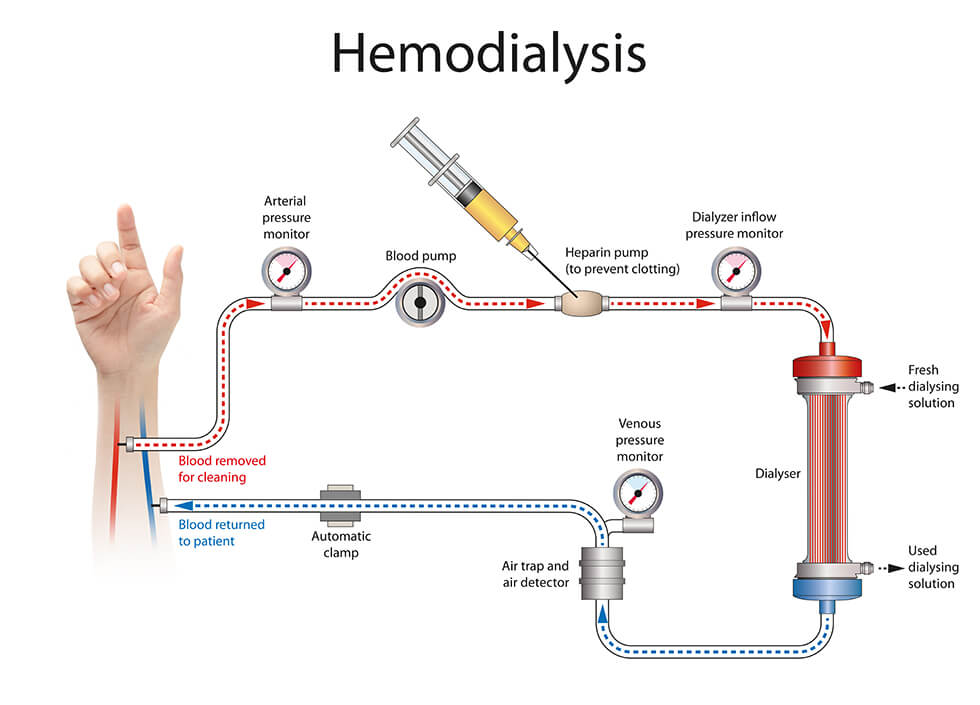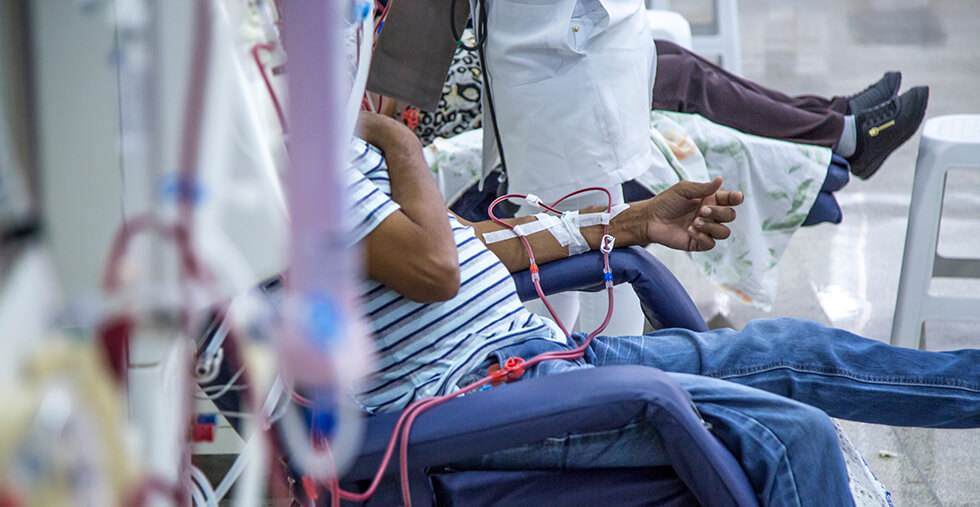Hemodialysis: What to Expect
Dialysis is a lifesaving step in kidney disease treatment. When the kidneys no longer filter blood and remove waste and fluids properly, dialysis can take over these functions. Doctors typically prescribe dialysis to patients with kidney failure or end stage renal disease. (The word renal refers to the kidneys.)

Dialysis is a lifesaving step in kidney disease treatment.
Many patients starting dialysis feel anxious about what to expect. They may be concerned about adjusting to a new schedule and meeting new health care providers. They wonder how the experience will affect their own lives.
This article explains hemodialysis, which uses a machine to filter the blood. With another type of dialysis, peritoneal dialysis, the lining of a person’s abdomen (called the peritoneum) is used to clean the blood and remove appropriate amounts of fluid.
What is hemodialysis?
Hemodialysis may take place at a hospital, a dialysis center, or even at home.
During the procedure, a hemodialysis machine uses a filter called a dialyzer to filter the blood. Blood is drawn from the body and travels to the machine, which removes wastes and other fluids. Once clean, the blood travels back into the body.
Hemodialysis may take place at a hospital, a dialysis center, or even at home. Often the decision depends on where the patient lives, their schedule, their lifestyle, and how much help they may have at home.
Time spent on dialysis can vary as well. People who receive dialysis at dialysis centers may have three treatments a week, lasting three to five hours each. Those who have dialysis at home might have shorter, but more frequent, treatments.
Vascular access for hemodialysis
Before a person can start hemodialysis, they need to have a simple surgical procedure to create a vascular access — an area where blood can be drawn and returned to the body during dialysis treatment.
The location of the access site can vary, but it is usually in the forearm or upper arm, depending on the patient’s anatomy. Options may include:
- Fistula. The surgeon connects an artery and vein, creating a larger blood vessel that allows for more blood flow.
- Graft. The surgeon connects the artery and vein with a soft tube
Some people receive a tube called a catheter, especially if they are having dialysis temporarily. The catheter may be placed in a vein in the neck, chest, or leg.
The procedure is usually done on an outpatient basis with local anesthesia. Most patients go home the same day.
Ideally, the vascular access is created a few months before a person starts hemodialysis so that the area has time to heal. Once in place, it’s important to keep the access area clean and take precautions against infections. Healthcare staff teach patients how to take care of their vascular access.

At a dialysis center or hospital
During dialysis, patients may read books, watch movies, text with friends, listen to podcasts, or just relax and take a nap.
Dialysis centers and hospitals have everything a person needs for dialysis. They have expert technicians who are trained to set up equipment and interpret results. They may also have dietitians (who can answer questions about nutrition) and social workers (who can connect people with other services that may be needed outside the center, such as transportation arrangements or counseling).
Patients who have dialysis in these settings may need to have sessions three times a week for three to four hours at a time. Some centers offer nighttime treatments, which happen while a person is asleep. A doctor will prescribe a specific dialysis protocol.
Once a patient gets settled, the dialysis usually follows these steps:
- The dialysis nurse inserts two needles into the vascular access. A numbing spray may be applied first to relieve any discomfort. Patients who are troubled by needles may choose to look away at this point. One needle draws blood out to the machine. The other provides the path for blood to return to the body.
- The needles are connected to tubes on the machine.
- Blood is drawn from the body, through one of the needles, and into the machine for filtering. The blood is cleaned by a special dialysis solution that contains water, salt, and chemicals.
- Clean blood is returned to the body through the other needle. When blood is flowing in or out of the access site, patients feel a vibration.

Dialysis takes several hours, so many patients bring something to do while they’re at the center. They may read books, watch movies, text with friends, listen to podcasts, or just relax and take a nap.
Problems are rare, but if one occurs, the machine will stop and an alarm will sound. A staff member will come right away to help.
Side effects of hemodialysis
Some patients experience side effects, such as the following:
- Tiredness
- Nausea
- Dizziness
- Headaches
- Pain in the chest or back
- Muscle cramps
- Restless leg syndrome
- Itchy skin
Dialysis center nurses monitor patients for side effects and take care of symptoms as needed.
Hemodialysis at home
Some people choose to have their dialysis treatments at home. Home dialysis can be a convenient option, especially for patients who live far from a dialysis center. The schedule can be more flexible as well, making it easier to work and travel.
Home hemodialysis uses smaller machines, and the treatment sessions may be shorter and more frequent. There are three types:
- Conventional home hemodialysis. Treatments occur three times a week for three to five hours. This frequency is similar to dialysis at a center.
- Short daily home hemodialysis. Five to seven treatments are done per week, with each treatment lasting two to four hours.
- Nocturnal home hemodialysis. Treatments occur while a person sleeps. They may be scheduled for several nights a week and last six to eight hours.
Because short daily home hemodialysis and nocturnal home hemodialysis filters blood more frequently, there may be fewer side effects. People may need less medication, have more energy, and have a better quality of life.
Training for home hemodialysis
Home hemodialysis requires extensive training for the patient and, usually, a care partner who can help out. Training sessions may last for eight weeks. Patients and care partners learn everything they need to know about home hemodialysis:
- Working with, cleaning, and maintaining the equipment
- Preventing infections
- Checking the patient’s temperature, blood pressure, weight, and pulse
- Troubleshooting the machine and responding to any alarms
- Keeping good records for the doctor
- Making sure supplies are well stocked
After hemodialysis
Immediately after dialysis, some patients feel tired and may need to rest for a little while. But eventually, most people find they have more energy and a better appetite.
People undergoing any type of hemodialysis should see their doctor regularly for follow-up visits. They may also need to take certain medications, change their diet, or limit the amount of fluids they take in. The doctor will let them know what changes to make.
Patients should call their doctor right away if they have:
- Severe pain
- Trouble urinating
- Fainting
- Signs of infection, such as a fever or irritation at the vascular access site
Resources
Cleveland Clinic
“Dialysis”
(Last reviewed: August 18, 2021)
https://my.clevelandclinic.org/health/treatments/14618-dialysis
National Institute of Diabetes and Digestive and Kidney Diseases
“Hemodialysis”
(Last reviewed: January 2018)
https://www.niddk.nih.gov/health-information/kidney-disease/kidney-failure/hemodialysis
National Kidney Foundation
“8 Activities to Try During Dialysis”
(April 11, 2022)
https://www.kidney.org/newsletter/8-activities-to-try-during-dialysis
“Getting Ready for ‘A New Normal’”
(2007)
https://www.kidney.org/sites/default/files/docs/11-10-0306_dialysistransitionbk1_oct07_lr_bm.pdf
“Hemodialysis”
(2015)
https://www.kidney.org/atoz/content/hemodialysis
“Hemodialysis Access”
(2015)
https://www.kidney.org/atoz/content/hemoaccess
“Home Hemodialysis”
(2015)
https://www.kidney.org/atoz/content/homehemo
“A ‘New Normal’: Life on Dialysis—The First 90 Days”
(2007)
https://www.kidney.org/sites/default/files/docs/11-10-0307_dialysistransitionbk2_oct07_lr_bm.pdf

